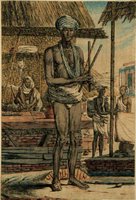Kumar had original Solvyns in his collection and promoted the artist…
 The name of the uncle and nephew team of Thomas and William Daniell were well known. But very few had heard the name of Solvyns. Kumar collected the prints of François Balthazar Solvyns and encouraged studies on the artist. Was Solvyns the only artist to reside in the native quarters of Calcutta to record the character of Calcutta? While others were engrossed with the scenic beauty of India in general and Calcutta in particular, Solvyns involved himself in the study of the costumes, manners, dress of the people of Calcutta. That is what made him unique. Solvyns (1760-1824), a Belgian artist, born in Antwerp sailed for Calcutta in 1790. He first noticed the keen interest shown by the British in Indian costumes and way of life after completing the Illustrations for a report on Kyd's expedition to Penang and the Andaman Islands.
The name of the uncle and nephew team of Thomas and William Daniell were well known. But very few had heard the name of Solvyns. Kumar collected the prints of François Balthazar Solvyns and encouraged studies on the artist. Was Solvyns the only artist to reside in the native quarters of Calcutta to record the character of Calcutta? While others were engrossed with the scenic beauty of India in general and Calcutta in particular, Solvyns involved himself in the study of the costumes, manners, dress of the people of Calcutta. That is what made him unique. Solvyns (1760-1824), a Belgian artist, born in Antwerp sailed for Calcutta in 1790. He first noticed the keen interest shown by the British in Indian costumes and way of life after completing the Illustrations for a report on Kyd's expedition to Penang and the Andaman Islands. In 1799 he published, in Calcutta, what was in effect a preliminary edition of the present work: A Collection of Two Hundred and Fifty Coloured Etchings of the Manners, Customs, and Dress of the Hindoos. Unfortunately, the work was a financial failure largely due to the images being poorly executed by European standards. This first attempt did however attract the attention of the eminent orientalist Sir William Jones, and it was with his enthusiastic support that Solvyns pursued his aim of issuing a work that did justice to the subject. In 1803 he left India for France where he reworked and vastly improved the plates, he also prepared an enlarged text, in both French and English (translated by his wife Mary Anne Greenwood). This reworking and rewriting took years, and it was not until 1808 that the first part of the present work was published.
In 1799 he published, in Calcutta, what was in effect a preliminary edition of the present work: A Collection of Two Hundred and Fifty Coloured Etchings of the Manners, Customs, and Dress of the Hindoos. Unfortunately, the work was a financial failure largely due to the images being poorly executed by European standards. This first attempt did however attract the attention of the eminent orientalist Sir William Jones, and it was with his enthusiastic support that Solvyns pursued his aim of issuing a work that did justice to the subject. In 1803 he left India for France where he reworked and vastly improved the plates, he also prepared an enlarged text, in both French and English (translated by his wife Mary Anne Greenwood). This reworking and rewriting took years, and it was not until 1808 that the first part of the present work was published. Over the next four years it was issued in 48 parts with a total of 288 colour-printed plates, all beautifully finished by hand. The final result not only amply justifies Solvyn's self-belief but also was to prove to be an influential model for the so-called 'Company School' of Indian artists during the 19th century who produced suites of drawings of 'occupations' for the British serving in India.
Over the next four years it was issued in 48 parts with a total of 288 colour-printed plates, all beautifully finished by hand. The final result not only amply justifies Solvyn's self-belief but also was to prove to be an influential model for the so-called 'Company School' of Indian artists during the 19th century who produced suites of drawings of 'occupations' for the British serving in India. The four volumes are arranged by sections with illustrations that take in all social classes and picture the customs, festivals, costume and the caste system of the Hindus. In fact years later Professor Robert L. Hardgrave, Jr Temple Professor of the Humanities in Government and Asian Studies at the University of Texas, Austin, came searching for documents on Solvyns in Calcutta, and was referred to Kumar’s, by the United States Consulate. Professor Hardgrave is today an authority on Solvyns and his work, and has several researched books on him.
The four volumes are arranged by sections with illustrations that take in all social classes and picture the customs, festivals, costume and the caste system of the Hindus. In fact years later Professor Robert L. Hardgrave, Jr Temple Professor of the Humanities in Government and Asian Studies at the University of Texas, Austin, came searching for documents on Solvyns in Calcutta, and was referred to Kumar’s, by the United States Consulate. Professor Hardgrave is today an authority on Solvyns and his work, and has several researched books on him.Images : Solvyns Self-Potrait. The Four Volumes . Customs . People .







<< Home